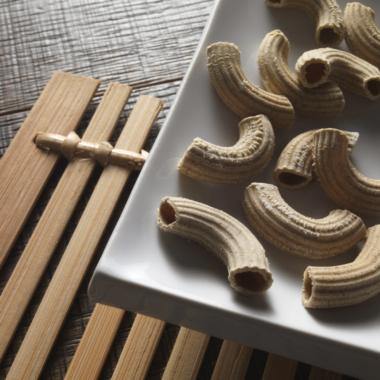Menu
Your basket is empty
Looks like you haven't added anything to your basket yet

Buckwheat Pasta - Gluten-free
Ingredients
Preparing the dough by hand:
300g buckwheat flour
2 fresh egg whites
125 ml cold water
Preparing the dough
- Create a well with the soft-wheat flour in a bowl; pour the egg whites and the water into the middle.
- Mix the flour, egg whites and water with a fork and knead the dough.
- Keep kneading the dough by hand until it is smooth and sticks together. If the dough is too dry, add some water, if it is too soft add some flour.
- Take the dough out of the bowl and place it on lightly floured table. Continue, if necessary, to knead the dough by hand; then, cut it into four pieces.
Preparing the Sheet (With Marcato Pasta Machine)
- Set the pasta machine thickness-adjustment to 0 and pass one of the four pieces of dough through the smooth rollers.
- Lightly dust both sides of the sheet of pasta with flour and fold it in half. Feed the sheet of pasta back through the smooth rollers again: repeat these operations several times until the sheet of pasta has a long and regular shape.
- Cut the resulting sheet into two pieces, and sprinkle them lightly with flour on both sides.
- Set the thickness-adjustment to 1 and pass the sheet through just once; then, set the thickness-adjustment to 2 and pass the sheet through once more; then, set the thickness-adjustment to 3, and so forth until you achieve the required thickness.
- Fit the attachment to the Atlas pasta machine or to the Mixer, if you are using the 3 Facile mixer, the selected cutting accessory and pass the sheet through the cutting rollers to achieve the required paste shape (No cutting accessories can be assembled on the Ampia pasta machine).
- Lastly, cook the pasta that you have made, or store it once you have left it to dry on a drying rack for at least one hour.
Preparing the Sheet (By Hand and Traditional Tools)
- Lightly dust both sides of the sheet of pasta with flour and fold it in half. Roll out the dough with a rolling pin: repeat this action several times until the sheet of pasta has a long and regular shape.
- Cut the resulting sheet into two pieces, and sprinkle them lightly with flour on both sides.
- Roll out the two pieces so the dough is in sheets about 2-3mm.
- Using your desired cutting tool, e.g. spaghetti cutter rolling pin, or pasta wheel, cut evenly onto the sheet.
- Lastly, cook the pasta that you have made, or store it once you have left it to dry on a suitable drying rack for at least one hour.
Tips For Fresh Pasta
|
|
- Choosing a selection results in a full page refresh.
